Three Wabash men elected to navigate Indiana’s length of the Wabash River to study its history, biology, and beauty.
 Since the middle of the 17th Century, the Wabash River has been home to a handful of different peoples. The French voyageurs, in search of pelts, made the first connections with the Native American peoples living in what would later become the States of Indiana, Ohio, Illinois, Michigan, and Kentucky. These states make up what was once called the Northwest Territory. The French fur traders were in search of pelts from the animals, most importantly beaver pelts, because they made the best felt hats that were extremely popular fashion in 17th and 18th century Europe.
Since the middle of the 17th Century, the Wabash River has been home to a handful of different peoples. The French voyageurs, in search of pelts, made the first connections with the Native American peoples living in what would later become the States of Indiana, Ohio, Illinois, Michigan, and Kentucky. These states make up what was once called the Northwest Territory. The French fur traders were in search of pelts from the animals, most importantly beaver pelts, because they made the best felt hats that were extremely popular fashion in 17th and 18th century Europe.
The first interactions between the Native Americans and the French established a political and economic relationship that would eventually lead to the birth of the United States and Indiana.
As we canoed the length of the River we had the opportunity to retrace the footsteps of the men and women, European and Native American, who laid the foundations for our country and our state.
 We visited the four major forts that sit, or once sat, along the banks of the Wabash River. They are Forts Recovery in Ohio, Ouiatenon in Lafayette, Harrison in Terre Haute, and Sackville in Vincennes. The story of Indiana’s beginnings can be told in the stories of these four forts. The forts along the Wabash are vital parts of both the River's and Indiana's history.
We visited the four major forts that sit, or once sat, along the banks of the Wabash River. They are Forts Recovery in Ohio, Ouiatenon in Lafayette, Harrison in Terre Haute, and Sackville in Vincennes. The story of Indiana’s beginnings can be told in the stories of these four forts. The forts along the Wabash are vital parts of both the River's and Indiana's history.
Webb '08 is a Wabash College history major from from Anderson, Ind.